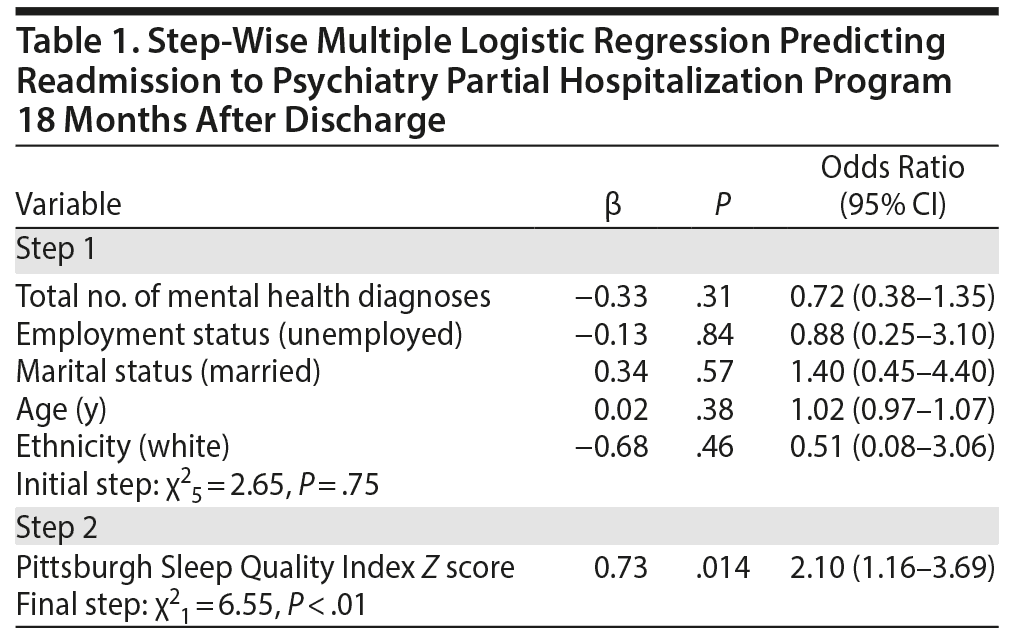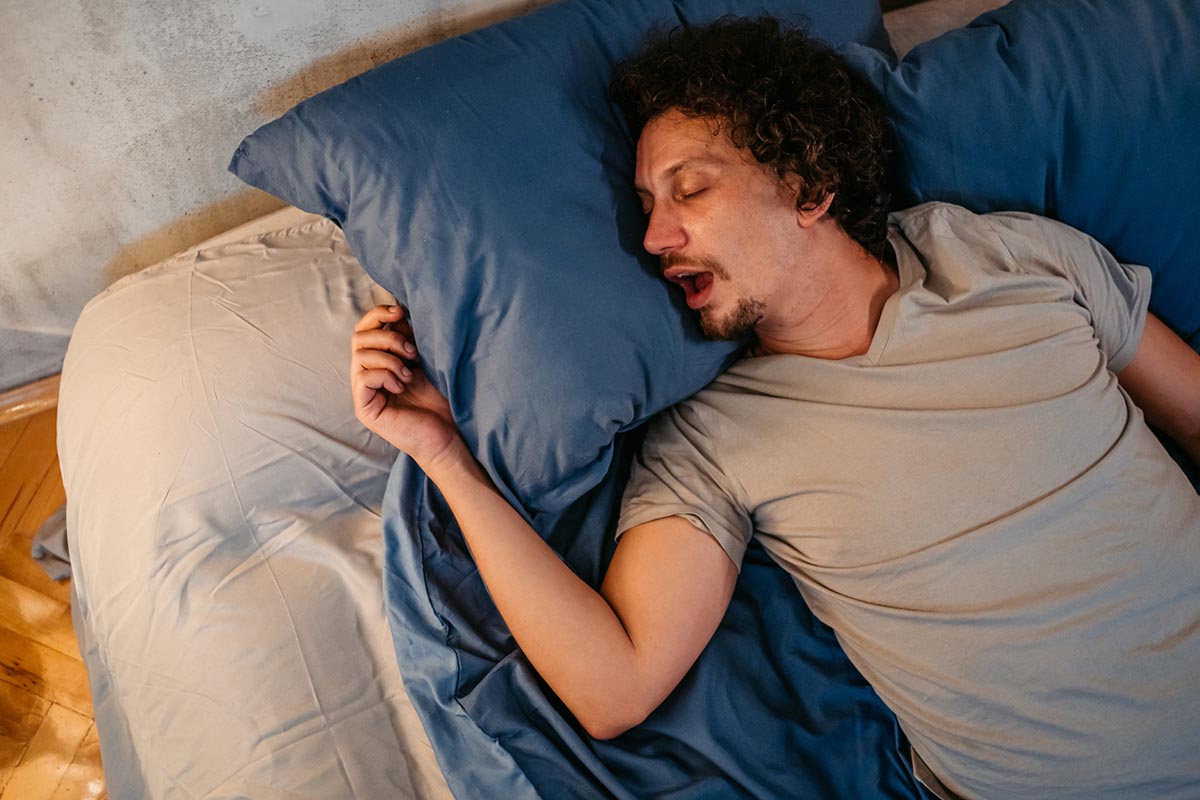Because this piece does not have an abstract, we have provided for your benefit the first 3 sentences of the full text.
To the Editor: Sleep disturbances commonly co-occur with mental disorders and often are sufficiently severe to warrant targeted treatment. Left untreated, sleep disturbances may exacerbate comorbid conditions and complicate recovery. Moreover, sleep disturbances are considered modifiable risk factors for onset and relapse of mental disorders.
Poor Sleep Quality at Discharge as a Predictor of Readmission to a Psychiatry Partial Hospitalization Program
To the Editor: Sleep disturbances commonly co-occur with mental disorders and often are sufficiently severe to warrant targeted treatment.1 Left untreated, sleep disturbances may exacerbate comorbid conditions and complicate recovery.2 Moreover, sleep disturbances are considered modifiable risk factors for onset and relapse of mental disorders.3 Numerous prospective longitudinal studies have demonstrated that the specific sleep disturbance of insomnia is a risk factor for psychiatric disorders and suicidal ideation or behavior.4-6
Very little work has been done to examine sleep disturbance as a risk factor for relapse within the context of acute psychiatric treatment within a partial hospital setting. The purpose of this retrospective chart review study was to examine the long-term follow-up over 18 months after discharge from a partial hospitalization program to determine if poor sleep quality at discharge predicts early readmission into the program. In our previous work,7 it was demonstrated that sleep improved for patients who completed this program. In this follow-up study, we examined whether patients with higher scores on the Pittsburgh Sleep Quality Index (PSQI)8 at discharge (indicating worse sleep quality) were at increased risk for rehospitalization, controlling for covariates related to mental health status.
Method. The PSQI was completed by 183 patients at the time of entry into a psychiatry partial hospitalization program (typically lasting 1 month) and again at discharge. The PSQI is a self-report scale for measuring sleep quality and has shown evidence of good reliability and validity.8 A retrospective chart review was conducted to examine predictors of readmission over an 18-month follow-up period. The institutional review board of the Minneapolis VA Health Care System (Minneapolis, Minnesota) approved this study. Data were collected between November 2007 and March 2009.
Results. The mean age of the patients was 48.2 years. Most participants were male (91.2%, n = 165), 152 (84.0%) were white, 56 (30.9%) were married, and 34 (18.8%) were currently employed. The mean number of mental health diagnoses (DSM-IV criteria) was 2.15. Poor sleep quality defined by a PSQI score ≥ 6 was significantly associated with readmission (P = .02), with 13.2% of patients with poor sleep quality readmitted compared to 0% with good sleep quality. As shown in Table 1, PSQI scores significantly predicted readmission over 18 months after controlling for covariates associated with mental health status, including total number of mental health diagnoses, employment status, marital status, age, and ethnicity (odds ratio = 2.10; 95% CI, 1.16-3.69). For every increase in 1 standard deviation on the PSQI, patients were twice as likely to be readmitted. Neither change in continuous PSQI scores nor change in categories based on clinical cutoffs over the course of treatment predicted readmission.
Overall, we found that poor sleep quality at discharge is predictive of readmission to a partial hospitalization program, suggesting the need for a higher level of sleep-focused care during and following psychiatric admission. Our earlier work7 suggests that sleep disturbances did improve over the course of treatment, but change in sleep was not predictive of readmission. This study highlights the need to identify and treat patients who have poor sleep quality following intensive mental health treatment to support remission and recovery.
There are several limitations to this study. First, covariates were determined from records and therefore are most likely less accurate than information obtained from diagnostic interviews. The data were also limited to dichotomous diagnoses; although this is not expected to introduce systematic bias regarding the direction and significance of the findings, it did prevent a more fine-grained analysis of continuous mental health symptom covariates for which sleep quality may be a proxy. Despite these limitations, this study is one of the first to evaluate the outcome following partial hospital treatment in those with poor sleep quality at discharge. This study highlights the importance of assessing poor sleep quality prior to discharge and incorporating behavioral or pharmacologic treatments for sleep disturbances into treatment planning.
References
1. American Psychiatric Association. Diagnostic and Statistical Manual of Mental Disorders. Fifth Edition. Washington, DC: American Psychiatric Association; 2013.
2. Smith MT, Huang MI, Manber R. Cognitive behavior therapy for chronic insomnia occurring within the context of medical and psychiatric disorders. Clin Psychol Rev. 2005;25(5):559-592. PubMed doi:10.1016/j.cpr.2005.04.004
3. Germain A. Sleep disturbances as the hallmark of PTSD: where are we now? Am J Psychiatry. 2013;170(4):372-382. PubMed doi:10.1176/appi.ajp.2012.12040432
4. Breslau N, Roth T, Rosenthal L, et al. Sleep disturbance and psychiatric disorders: a longitudinal epidemiological study of young adults. Biol Psychiatry. 1996;39(6):411-418. PubMed doi:10.1016/0006-3223(95)00188-3
5. Koffel E, Polusny MA, Arbisi PA, et al. Predeployment daytime and nighttime sleep complaints as predictors of postdeployment PTSD and depression in National Guard troops. J Anxiety Disord. 2013;27(5):512-519. PubMed doi:10.1016/j.janxdis.2013.07.003
6. Malik S, Kanwar A, Sim LA, et al. The association between sleep disturbances and suicidal behaviors in patients with psychiatric diagnoses: a systematic review and meta-analysis. Syst Rev. 2014;3(1):18. PubMed doi:10.1186/2046-4053-3-18
7. Khawaja IS, Dieperink ME, Thuras P, et al. Effect of sleep skills education on sleep quality in patients attending a psychiatry partial hospitalization program. Prim Care Companion CNS Disord. 2013;15(1):PCC.12m01440. PubMed doi:10.4088/pcc.12m01440
8. Buysse DJ, Reynolds CF III, Monk TH, et al. The Pittsburgh Sleep Quality Index: a new instrument for psychiatric practice and research. Psychiatry Res. 1989;28(2):193-213. PubMed doi:10.1016/0165-1781(89)90047-4
Author affiliations: Department of Psychiatry, University of Minnesota, Minneapolis (Dr Koffel); Minneapolis Veterans Affairs Health Care System, Minneapolis, Minnesota (Drs Koffel and Thuras); Philadelphia Veterans Affairs Medical Center, Perelman School of Medicine, Philadelphia, Pennsylvania (Dr Chakravorty); Department of Psychiatry, University of Pittsburgh School of Medicine, Pittsburgh, Pennsylvania (Dr Germain); and Minnesota Regional Sleep Disorders Center, Hennepin County Medical Center and Department of Neurology, University of Minnesota School of Medicine, Minneapolis (Dr Khawaja).
Potential conflicts of interest: None reported.
Funding/support: This material is the result of work supported with resources and the use of facilities at the Minneapolis VA Health Care System, Minneapolis, Minnesota and VA grant IK2CX000855 (Dr Chakravorty).
Role of the sponsor: The sponsor had no role in the design or conduct of this study.
Disclaimer: The views expressed in this article are those of the authors and do not reflect the official policy or position of the US Department of Veterans Affairs.
Published online: December 10, 2015.
Prim Care Companion CNS Disord 2015;17(6):doi:10.4088/PCC.15l01826
© Copyright 2015 Physicians Postgraduate Press, Inc.
Please sign in or purchase this PDF for $40.00.




